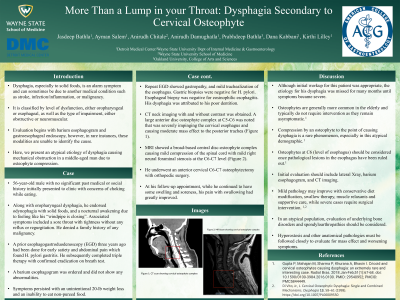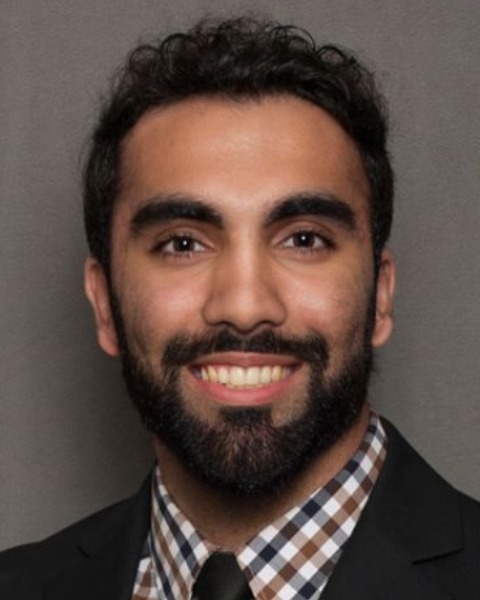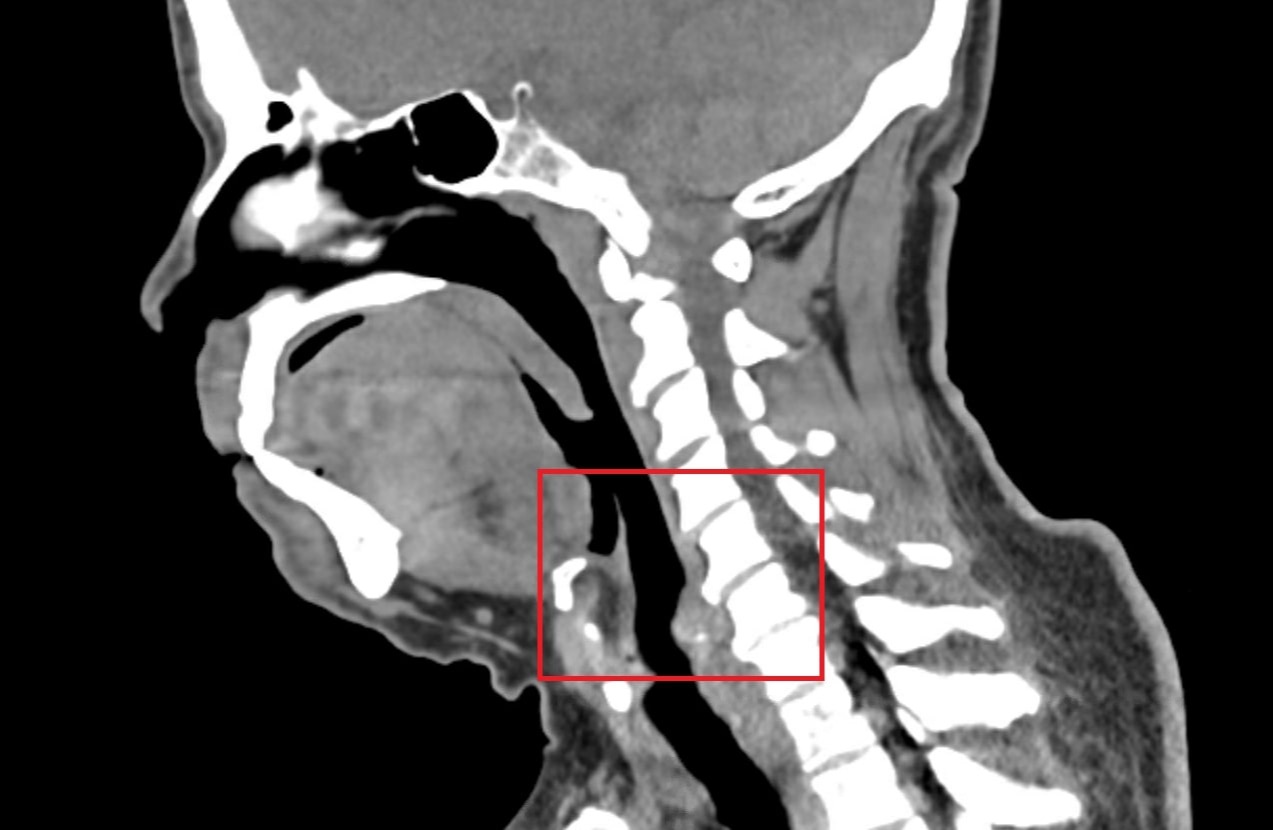Sunday Poster Session
Category: Esophagus
P0443 - More Than a Lump in Your Throat: Dysphagia Secondary to Cervical Osteophyte
Sunday, October 22, 2023
3:30 PM - 7:00 PM PT
Location: Exhibit Hall

Has Audio

Jasdeep Bathla, DO
Wayne State University School of Medicine / Detroit Medical Center
Detroit, MI
Presenting Author(s)
Jasdeep Bathla, DO1, Ayman Salem, MD2, Anirudh Chitale, BA3, Anirudh R. Damughatla, DO1, Prabhdeep Bathla, BA4, Dana Kabbani, MD2, Kirthi Lilley, MD1
1Wayne State University School of Medicine / Detroit Medical Center, Detroit, MI; 2Wayne State University/Detroit Medical Center, Detroit, MI; 3Wayne State University School of Medicine, Detroit, MI; 4Oakland University, Rochester, MI
Introduction: Dysphagia to solid foods is an alarm symptom and can be due to another medical condition such as stroke, infection, or malignancy. It is classified by region, either oropharyngeal or esophageal, as well as type, either obstructive or neuromuscular. Evaluation begins with barium esophagogram and gastroesophageal endoscopy, however, rarely, these modalities cannot identify the cause. Here, we present an atypical etiology of dysphagia causing mechanical obstruction in a middle-aged man due to osteophyte compression.
Case Description/Methods: A 56-year-old male presented to clinic with concerns of choking while eating. Along with oropharyngeal dysphagia to solids, he endorsed odynophagia and a nocturnal awakening due to his “windpipe closing”. Associated symptoms included sore throat without any reflux or regurgitation. He denied family history of malignancy. Barium esophagogram did not show any abnormalities. A prior esophagogastroduodenoscopy (EGD) three years ago showed no structural abnormalities. Symptoms persisted including an unintentional 20-lb weight loss and inability to eat non-pureed food. Repeat EGD showed poor dentition, gastropathy, and mild trachealization of the esophagus, with negative biopsies for H. pylori or eosinophilic esophagitis. His dysphagia was attributed to poor dentition. Due to ongoing symptoms and weight loss, CT neck imaging with and without contrast was obtained. A large anterior disc osteophyte complex at C5-C6 was noted that was severely impinging the cervical esophagus and posterior trachea. MRI showed a broad-based central disc-osteophyte complex causing mild compression of the spinal cord with mild right neural foraminal stenosis at the C6-C7 level. He underwent anterior cervical C6-C7 osteophytectomy with orthopedics. At his follow-up, he continued to have some swelling and soreness, but his odynophagia had greatly improved.
Discussion: This case is unique in that the atypical etiology of dysphagia was missed on initial testing. Osteophytes are more common in the elderly and typically do not require intervention as they generally remain asymptomatic. Mild pathology may improve with diet modification, swallow therapy, muscle relaxants and supportive care, while severe cases require surgical intervention. In an atypical population, evaluation of underlying bone disorders and spondyloarthropathies should be considered. Hyperostosis and other anatomical pathologies must be followed closely to evaluate for mass effect and worsening symptoms.

Disclosures:
Jasdeep Bathla, DO1, Ayman Salem, MD2, Anirudh Chitale, BA3, Anirudh R. Damughatla, DO1, Prabhdeep Bathla, BA4, Dana Kabbani, MD2, Kirthi Lilley, MD1. P0443 - More Than a Lump in Your Throat: Dysphagia Secondary to Cervical Osteophyte, ACG 2023 Annual Scientific Meeting Abstracts. Vancouver, BC, Canada: American College of Gastroenterology.
1Wayne State University School of Medicine / Detroit Medical Center, Detroit, MI; 2Wayne State University/Detroit Medical Center, Detroit, MI; 3Wayne State University School of Medicine, Detroit, MI; 4Oakland University, Rochester, MI
Introduction: Dysphagia to solid foods is an alarm symptom and can be due to another medical condition such as stroke, infection, or malignancy. It is classified by region, either oropharyngeal or esophageal, as well as type, either obstructive or neuromuscular. Evaluation begins with barium esophagogram and gastroesophageal endoscopy, however, rarely, these modalities cannot identify the cause. Here, we present an atypical etiology of dysphagia causing mechanical obstruction in a middle-aged man due to osteophyte compression.
Case Description/Methods: A 56-year-old male presented to clinic with concerns of choking while eating. Along with oropharyngeal dysphagia to solids, he endorsed odynophagia and a nocturnal awakening due to his “windpipe closing”. Associated symptoms included sore throat without any reflux or regurgitation. He denied family history of malignancy. Barium esophagogram did not show any abnormalities. A prior esophagogastroduodenoscopy (EGD) three years ago showed no structural abnormalities. Symptoms persisted including an unintentional 20-lb weight loss and inability to eat non-pureed food. Repeat EGD showed poor dentition, gastropathy, and mild trachealization of the esophagus, with negative biopsies for H. pylori or eosinophilic esophagitis. His dysphagia was attributed to poor dentition. Due to ongoing symptoms and weight loss, CT neck imaging with and without contrast was obtained. A large anterior disc osteophyte complex at C5-C6 was noted that was severely impinging the cervical esophagus and posterior trachea. MRI showed a broad-based central disc-osteophyte complex causing mild compression of the spinal cord with mild right neural foraminal stenosis at the C6-C7 level. He underwent anterior cervical C6-C7 osteophytectomy with orthopedics. At his follow-up, he continued to have some swelling and soreness, but his odynophagia had greatly improved.
Discussion: This case is unique in that the atypical etiology of dysphagia was missed on initial testing. Osteophytes are more common in the elderly and typically do not require intervention as they generally remain asymptomatic. Mild pathology may improve with diet modification, swallow therapy, muscle relaxants and supportive care, while severe cases require surgical intervention. In an atypical population, evaluation of underlying bone disorders and spondyloarthropathies should be considered. Hyperostosis and other anatomical pathologies must be followed closely to evaluate for mass effect and worsening symptoms.

Figure: CT neck showing cervical osteophyte complex at C5-C6
Disclosures:
Jasdeep Bathla indicated no relevant financial relationships.
Ayman Salem indicated no relevant financial relationships.
Anirudh Chitale indicated no relevant financial relationships.
Anirudh R. Damughatla indicated no relevant financial relationships.
Prabhdeep Bathla indicated no relevant financial relationships.
Dana Kabbani indicated no relevant financial relationships.
Kirthi Lilley indicated no relevant financial relationships.
Jasdeep Bathla, DO1, Ayman Salem, MD2, Anirudh Chitale, BA3, Anirudh R. Damughatla, DO1, Prabhdeep Bathla, BA4, Dana Kabbani, MD2, Kirthi Lilley, MD1. P0443 - More Than a Lump in Your Throat: Dysphagia Secondary to Cervical Osteophyte, ACG 2023 Annual Scientific Meeting Abstracts. Vancouver, BC, Canada: American College of Gastroenterology.
